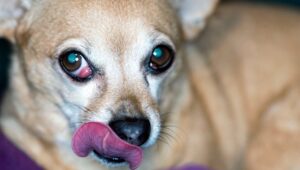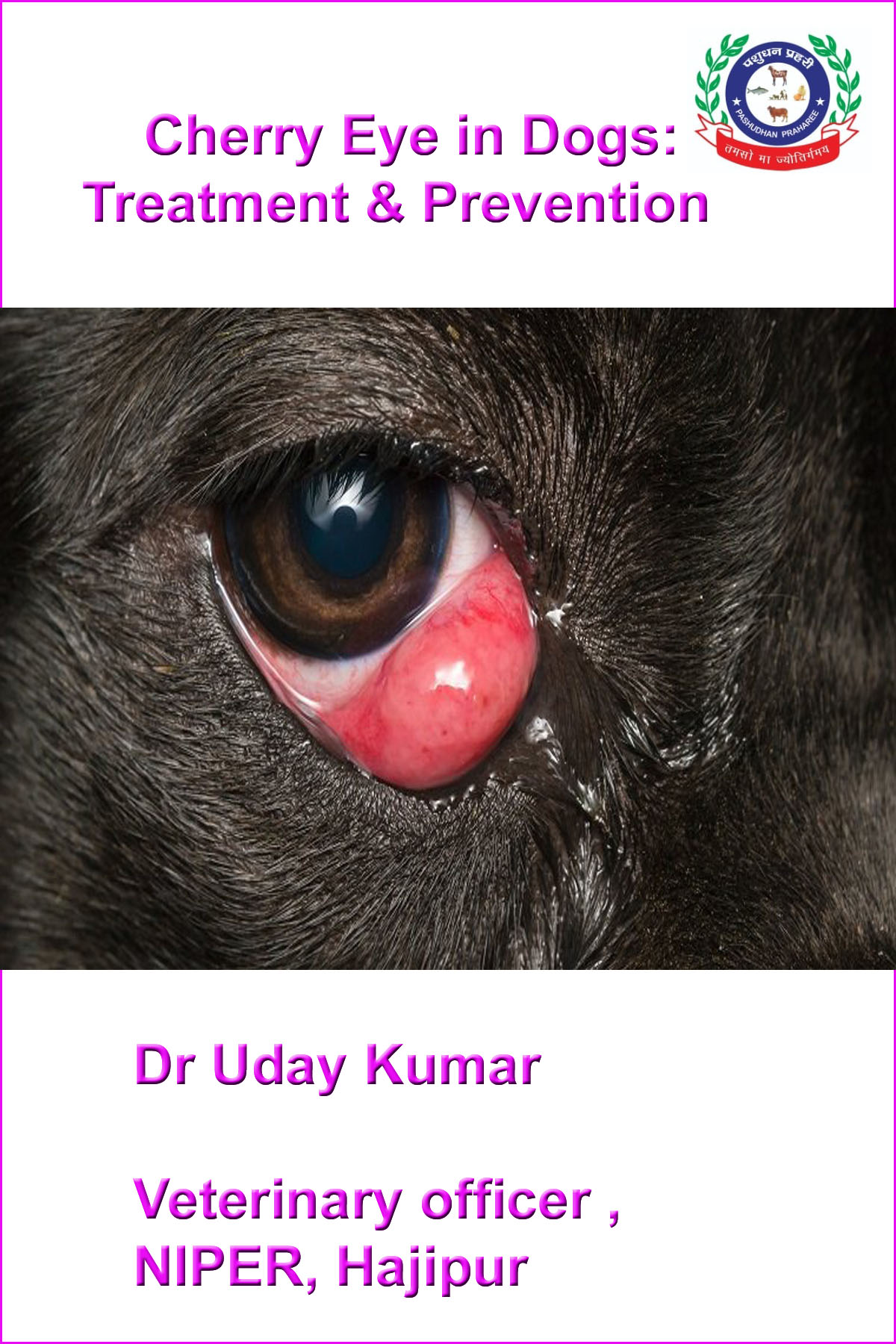Cherry Eye in Dogs:Treatment & Prevention
Dr Uday Kumar
Veterinary officer at NIPER Hajipur, National Co-convener at Indian Veterinary Association
Unlike their human counterparts, dogs have not two but three eyelids for each eye. This third eyelid, called the nictitating membrane, is found inside the lower eyelid and provides an added layer of protection for your pup’s eyes. It also contains an important gland that supplies much of your dog’s tears.
Many mammals, including dogs, have an “extra” or third eyelid located inside the lower eyelid, also referred to as the “nictitating membrane.” The third eyelid serves as an additional protective layer for the eye, especially during hunting or fighting. The third eyelid also contains a special gland that produces a significant portion of the eye’s protective tear film. When this gland prolapses or “pops out”, the condition is known as “cherry eye”.
What is Cherry Eye?
“Cherry eye” is the nickname for a medical condition known as a prolapsed nictitating membrane, prolapsed third eyelid, or third eyelid gland prolapse. The third eyelid, or nictitating membrane, is this fleshy, pink part next to the eye in the eye socket. This membrane is actually a flap of tissue that contains a gland that secretes tears and is usually not easily seen. It should be flat and against the corner of the eye socket but in a dog with cherry eye, it gets enlarged, flips over, and protrudes or prolapses making it abnormally visible.
Signs of Cherry Eye in Dogs
- Pink bulge in the corner of the eye
- Pawing or rubbing at the eye
- Unable to close eye
Prolapse of the third eyelid gland appears as a red swollen mass on the lower eyelid near the nose or muzzle (it takes its name from the resemblance to a cherry). The “cherry eye” may be large and cover a significant portion of the cornea, or it may be small and appear only periodically. Any sign of “cherry eye” should be brought to your veterinarian’s attention immediately.
A dog with a cherry eye will have a pink or red bulge that appears to be coming out of the inner corner of the eye. This bulge won’t be bleeding and is not painful but is usually pretty obvious to an owner. Sometimes the bulge will come and go but other times the cherry eye will be out permanently until veterinary care is received. Aside from this obvious pink bulge in the eye though, other problems and symptoms that your veterinarian may see in a dog with a cherry eye include dry eye, corneal ulcers, irritation, and inflammation of the cornea. These conditions then cause a dog to paw at or rub its eyes.
Dry eye develops due to a lack of tear production and since the third eyelid is responsible for making tears, if it is inflamed and not providing enough tears, the eye will not be properly lubricated. This can then also cause irritation, inflammation, and even ulcers on the eye, especially if a dog paws at it or rubs it on the ground. If a cherry eye is large enough, it may also make it difficult or impossible for a dog to completely close its eyes. This can also be a contributing factor for dry eye if the eye is kept partially open at all times.
Causes of Cherry Eye in Dogs
Cherry eye is something a dog can be born with but more often it develops over time. The condition is most commonly seen in dogs that are 2 years of age or younger but some breeds are more likely to develop cherry eye than others. These breeds include American Cocker Spaniels, Shih Tzus, Beagles, Lhasa Apsos, Pekingese, Maltese, Bassett Hounds, Rottweilers, Neapolitan Mastiffs, Shar-Peis, Boston Terriers, St. Bernards, and English Bulldogs.
Treatment of Cherry Eye in Dogs
Over the years, several surgical methods have been devised to treat cherry eye in dogs. Surgical replacement of the cherry eye is the ideal treatment choice in order to preserve the tear production in the gland but occasionally the gland needs to be removed. If surgical replacement is unsuccessful and the removal of the gland is necessary, there is a risk for a dog developing chronic dry eye so your dog will be monitored for this.2 Simply pushing or massaging the cherry eye back into place with a wet cloth at home may work if the gland just popped out but it will depend on the severity of the cherry eye and how long it has been out. Typically this is only a temporary fix, if it works at all.
Your veterinarian will choose the surgical plan to replace the cherry eye that they are most comfortable with but a modification of one of three methods is typically used. The three methods most often used are called orbital rim anchoring, scleral anchoring, or the most popular, the pocket method. Variations of the pocket method have shown in some studies to be the most successful3 surgical plan for cherry eye replacements so many vets opt to utilize that technique.
Various medications, both oral and ocular, may be prescribed to help manage pain and inflammation as well as prevent infection but an E-collar should also be worn until the eye has completely healed. This will help prevent damage to the surgical site. Tear production may also be monitored when your dog’s eye is rechecked after surgery to ensure the replaced gland is still adequately producing enough tears and your dog doesn’t have dry eye. If dry eye has occurred, lifelong management with eye medications will be required.
How to Prevent Cherry Eye in Dogs
No one really knows what exactly causes this issue but some dogs simply have a genetic predisposition to developing it. There is no way to prevent it from occurring in your dog but thankfully it is not a life threatening condition and can be managed with surgery and medications.
What’s the Prognosis for Dogs with Cherry Eye?
Cherry eye is not life-threatening, and the vast majority of dogs go on to live full lives with healthy eyes. If you’re wondering if you should get a dog who has cherry eye—either from a rescue or a breeder—there are a few considerations to keep in mind.
First, it’s important to remember cherry eye is not contagious, so it poses no risk to you or other pets. However, surgical treatment of cherry eye can be expensive. Costs range from several hundred to thousands of dollars depending on the breed, your location, and your veterinarian’s rates for surgical procedures. And, since as many as 40 percent of dogs that experience cherry eye in one eye will eventually have it in the other, you could very well end up doubling your expenses.
The good news is, the simple cherry eye surgery should solve the problem for good. “Greater than 90 percent of the surgically repositioned tear glands stay in place. The most common complication of this surgery is the breakdown of the suture line and subsequent re-prolapse of the gland. If the suture does fail, another surgery is likely necessary.
The condition is not an indicator of poor health or of other underlying conditions. If your pup has cherry eye, there’s no reason she can’t enjoy a long, happy, healthy life post-treatment.
Is it Possible to Prevent Cherry Eye?
Unfortunately, there’s no way to keep your dog from developing cherry eye. But there are ways to give your pup the best chance at good health. Feed her a good diet and provide lots of exercise to maintain a healthy weight. Schedule an appointment with your vet to make sure she stays up-to-date on all preventative care and vaccinations, and reach out to your vet if you have any concerns about your pup’s eye health.

(Picture Credit: James Kelley/Getty Images)


